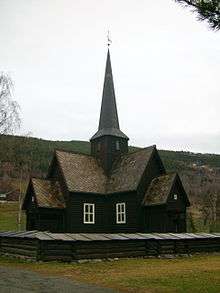Heidal


Heidal is a valley and parish within Gudbrandsdalen valley, in the county of Oppland, Norway.[1]
History
Heidal parish was separated from Vågå as a separate municipality of its own on 1 January 1908. It was merged with the municipality of Sel on 1 January 1965.
Heidal is a side valley of Gudbrandsdalen. The valley runs northwest from the village of Sjoa on Highway E-6, some 10 km before the community center of Otta. Heidal is rich in beauty and tradition, lying along the narrow valley of the Sjoa River. The Sjoa runs from Lake Gjende in the Jotunheimen Mountains, through Heidal and down to the Gudbrandsdalslågen river. It has a high concentration of older protected timber houses and farmsteads. The main industries are agriculture and forestry. Local traditions includes carpentry, wood carving, painting and weaving.[2]
Heidal church (Heidal Kirke) was built during the period 1937-41 as an exact replica of a 1754 church which was destroyed after being struck by lightning in 1933. Heidal Church is a cruciform church as are most of the churches in Gudbrandsdalen. The church was built of wood. It has about 300 seats and three galleries. The church was designed by architect, Bredo Berntsen (1877-1957). The altarpiece is a work by the Norwegian sculptor, Jakob Klukstad. Near the church stands the Bjølstad Chapel (Bjølstad-kapellet). Bjølstad Chapel seating 75 and dates from around 1531.[3]
Some locations allow guided tours, including Søre Harildstad farm and Bjølstad Chapel. Farms like Bjølstad are not open to the public. At Bjølstad the newest building was constructed in about 1820 and the farm has been in the same family since the 13th century. [4]
Gjesling family
1177 - Ivar Gjesling (or Ivar Gjæsling) was King Magnus IV's lendmann for the Opplands. Gjesling allied himself with the Birkebeiner — who chose Sverre as their king at Øreting in Nidaros in 1177. In return King Sverre granted Gjesling the valley of Heidal.[5]
See also
References
- ↑ Heidal Valley (Heidalsguiden 2010)
- ↑ Heidal historielag
- ↑ Heidal Kyrkje (Heidalsguiden 2010)
- ↑ Søre Harildstad (St Olav's Rose)
- ↑ Stagg, Frank Noel (1956). East Norway and its Frontier. George Allen & Unwin, Ltd. ISBN none.
Other sources
- Kleiven, Ivar (1973) Gamal bondekultur i Gudbrandsdalen: Lom og Skjaak (Forlagt Av H. Aschehoug & Co.) ISBN 978-82-03-05951-3
- Welle-Strand, Erling (1996) Adventure Roads in Norway (Nortrabooks) ISBN 82-90103-71-9